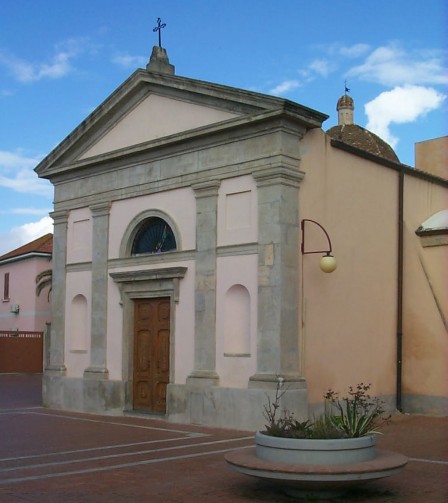The parish church dedicated to the Most Holy Savior was built in one of the higher parts of the village so that it could be seen in its entirety even from the highway.
The layout dates from the 17th-18th centuries and is in the late Baroque style while the facade is in the Classical style even though the structure was built at different times.
The earliest plant dates back to 1610 and is represented by the Pieta Chapel, immediately afterwards the Rosary Chapel was built in 1650, the dome was completed in 1770, and the bell tower in 1844.
The facade is divided into four symmetrical pilasters surmounted by capitals, while on the sides are two niches.
Above the 19th-century portal is a lunette-shaped window, and the facade is surmounted by a classicist triangular tympanum.
On either side are chapels, and the bell tower is positioned at the back.
The domes are octagonal in plan and culminate in the lantern.
The interior features a central plan, and the ceiling is wooden and trussed.
On either side stand six chapels built at different times.
The high altar is made of polychrome marble and articulated in different planes; it has two steps at the base.
At the top is a niche supported by four small black marble columns with Ionic capitals.
Inside the niche we find the wooden statue of St. Savior.
The author of the statue is unknown but it is thought it may have been executed by the same sculptor as the statue of St. Mary, namely Antonio Lonis of Senorbì.
On either side of the altar are the two barrel-vaulted chapels of the Pieta and the Rosary.
The altar is surmounted by a painting by an unknown author depicting the deposition of Christ from the cross.
Adjacent to the Rosary Chapel is the 1878 pulpit that was commissioned by Cav.
Mereu and Senior Alderman Giuseppe Angius: it is made of white marble, resting on a pilaster, and is in the late Baroque style.
On either side of the entrance we find on the left the Pila dell’Acquasantiera, in Romanesque style, from the church of Santa Maria di Sibiola, and on the right the Baptismal Font, of the Genoese school, in polychrome marble and wood.
The upper part is in inlaid wood and reproduces the scene of the Baptism of Christ.
The Sacred Heart Chapel houses the bodies of Monsignor Agostino Saba and Monsignor Paolo Carta.









